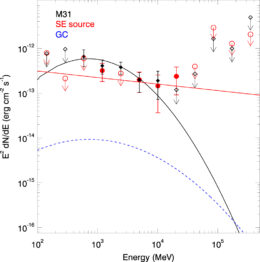Editor’s Note: Astrobites is a graduate-student-run organization that digests astrophysical literature for undergraduate students. As part of the partnership between the AAS and astrobites, we occasionally repost astrobites content here at AAS Nova. We hope you enjoy this post from astrobites; the original can be viewed at astrobites.org.
Title: On the Gamma-Ray Emission of the Andromeda Galaxy M31
Authors: Yi Xing et al.
First Author’s Institution: Shanghai Astronomical Observatory, Chinese Academy of Sciences
Status: Published in ApJL
Gamma rays are the highest-energy photons in our universe. Naturally, they come from some of the most extreme environments in the universe, such as pulsars, active galactic nuclei, supernovae, and potentially even dark matter. Though many gamma-ray sources have been detected both in the Milky Way and extragalactically, the nature of gamma-ray emission from our closest neighbouring galaxy, Andromeda (or Messier 31), remains somewhat of a mystery.
The Fermi Large Area Telescope (Fermi-LAT) is an instrument on the Fermi Gamma-ray Space Telescope that has been surveying the sky for high-energy gamma rays since 2008, with ample data taken on Andromeda throughout its flight. Many groups have analyzed these data, with more data giving more insight into what’s making these gamma rays.
To Extend or Not to Extend?
Up until today’s article, it looked like gamma rays from Andromeda were coming from a blob-like shape (i.e., extended emission) surrounding the centre of the galaxy (similar to Figure 1, left). This was particularly exciting, since extended structure in gamma-ray emission often suggests either a distribution of cosmic rays or the presence of a massive dark matter halo.

Figure 1: Significance maps of Andromeda at energies from 0.1 to 500 gigaelectronvolts (left) and 2 to 500 gigaelectronvolts (right). The region of optical emission is represented by the white contour. The colorbar corresponds to test statistic, which is similar to significance. A test statistic of 25 corresponds to a detection. Green markers correspond to nearby sources found in the SIMBAD database. The left figure shows a hint of additional structure in the southeast region of Andromeda, but both point sources emerge out of the seemingly extended region only with the lowest energies cut out. [Xing et al. 2023]
Where are the Gamma Rays Coming From?

Figure 2: A spectral energy distribution showing flux (quantity of gamma rays received) plotted against energy of Andromeda’s centre (black) and southeast (red) emission regions, along with the Milky Way’s galactic centre (blue). It is apparent that both sources are not only similar in brightness but are also producing significantly more gamma rays than our galactic centre. Click to enlarge. [Xing et al. 2023]
This new picture of Andromeda’s gamma rays changes a lot about our understanding of the galaxy. It’s no longer likely that Andromeda’s central gamma-ray hotspot is coming from a dark matter halo or cosmic ray distribution, so the authors looked to the Milky Way’s galactic centre to figure out what sorts of objects could be responsible for the gamma rays. One of the leading theories for our own galactic centre gamma rays is a population of old, unresolved objects, such as millisecond pulsars. However, in the case of Andromeda, at least 15,000 millisecond pulsars would be needed to account for the especially bright gamma-ray emission. While it’s still uncertain whether or not the centre of Andromeda can host this huge number of pulsars, we’ve only detected around 200 in the Milky Way’s centre, so this explanation seems unlikely.
The authors also investigate the southeast source that appeared in their new analysis. Since galaxies are pretty far apart from one another, the chance of finding two or more galaxies by coincidence in a circle drawn around both the central and southeast sources is only ~0.4%. This means that the emission is most likely coming from within Andromeda. As seen in Figure 2, the off-centre source is almost exactly the same brightness as Andromeda’s centre source (which is peculiar in its own right!), leading to the same problem of identifying sources capable of emitting such bright emission. After looking through X-ray and optical surveys, the authors determined that there weren’t any good counterparts for this region in other wavelengths either. Even considering the low probability of this being an extragalactic source behind Andromeda, there aren’t any known counterparts in the region of the sky where this hotspot is located.
The results are certainly unexpected and open up a whole new can of worms when it comes to figuring out the origin of the gamma rays in our neighbouring galaxy. Even though there are still a lot of unknowns, future observations and analyses of these newly constrained regions will help us understand how bright gamma rays are produced near the centres of galaxies and may even help us better understand our own galactic centre.
Original astrobite edited by Ivey Davis and Katya Gozman.
About the author, Samantha Wong:
I’m a graduate student at McGill University, where I study high-energy astrophysics. This includes studying all sorts of extreme environments in the universe like active galactic nuclei, pulsars, and supernova remnants with the VERITAS gamma-ray telescope.

